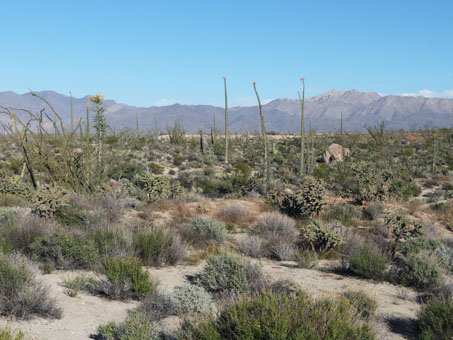THE UC HIVE JUL 2023
In the Aftermath of Hurricane Kay — Part 1
San Felipe, BC to
Guerrero Negro, BCS — Early November 2022
Summer 2022 on the Baja California peninsula was a particularly wet one. At least two tropical storms and one hurricane brought rain in September with additional smaller, localized events occuring over the summer.
Hurricane Kay passed along the entire west coast of the peninsula, coming closest to shore across the Vizcaíno Desert region around Guerrero Negro. Its effects were felt as far north as the San Diego area. The storm made landfall as a Cat. 2 hurricane. As it moved northward off the west coast of the peninsula, it dropped copious amounts of rain, causing flooding and landslides over a large area.
Our southern migration took us from San Felipe to Mulegé in early November. We´d missed some of the ephemeral plants from soon after the storms, but there were still telltale signs of the summer bloom along the route, as well as new growth of winter annuals and perennials.

Here, with the eye almost mid peninsula, the extent of Kay can be seen, as cloudcover seems to engulf the entire peninsula as well as parts of southern California, encluding San Diego. (Photo credit: Earthstar Geographics/ NOAA/NOC/OCS... 2022)
San Felipe to Laguna Chapala
As we were leaving San Felipe, looking to the west from the top of the dune field that the highway passed along, we had a sweeping view of the dunes and desert floor below that was bathed in pink. The dense swathes of sand verbena were spectacular. It was a scene that would repeat itself several times farther south in the Central Desert.
Our first botanizing stop was in a dune field not far south of San Felipe. The shoulders of the road were damaged in many places from runoff or deep with sand, so I pulled over at the first turnout that came along once we were away from town. The dunes were rich with vegetation, both annual and perennial.

Slender Sand Verbena / Alfombrilla (Abronia gracilis, Nyctaginaceae) was abundant. This species of Sand Verbena is a peninsular near-endemic as populations are present in the state of Sonora as well.

Abronia gracilis is found from about Laguna Salada to Bahia de los Angeles (in ne BC) and San Quintin (in nw BC) southward to the Magdalena plain of w BCS.

White Bur-Sage, Burrobush / Huizapol (Ambrosia dumosa, Asteraceae). Finally, the leaves were fresh and green...
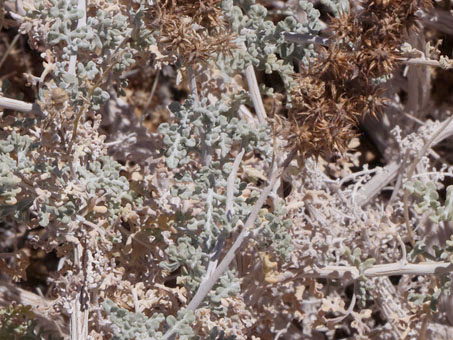
...as compared to our previous trips when the leaves were very gray or were completely dry and brittle.
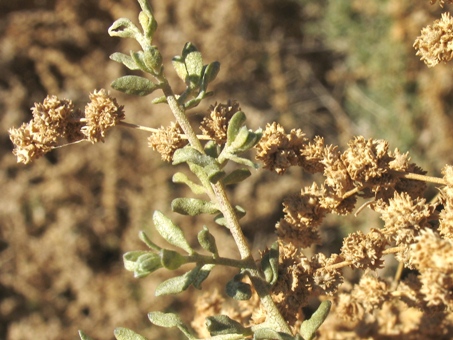
The leaves of Many-fruit Saltbush / Chamizo cenizo (Atriplex polycarpa, Chenopodiaceae) are oblong to oblanceolate, c. 1-2.5 cm L.

The pistillate flowers of Many-fruit Saltbush are densely packed on short, slender, branchlets. The margin of the 2-3 mm bracts are fused proximally & minutely toothed.

Southern Sandbur (Cenchrus palmeri, Asteraceae). The burs are each up to about 2.5 cm D and the barbs along the stiff, sharp spines catch like velcro. I stepped very carefully around the dune to avoid the burs.
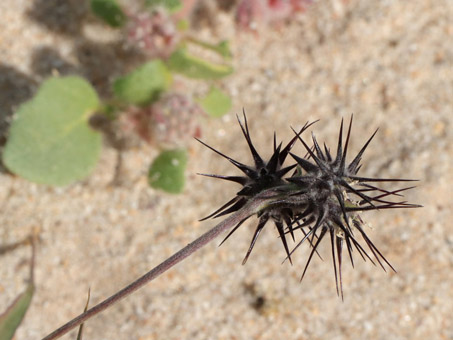
The female inflorescence of Southern Sandbur. Clicking on the image & zooming in on the right side, you can see a few of the pale anthers. I was very careful & not a single bur hitched a ride back to the car.
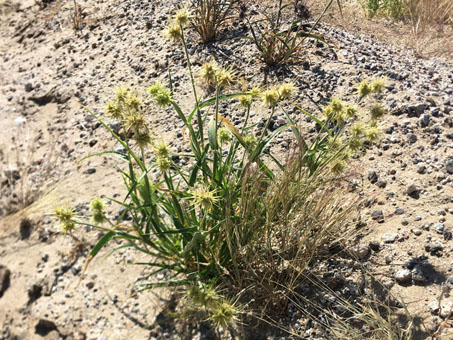
Southern Sandbur (Cenchrus palmeri) has burs that are maroon & mature black (as above), but can also have green burs that are...
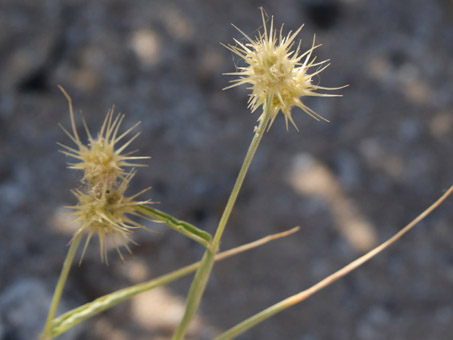
... yellowish tan when mature. It's not uncommon to find both colors within the same population. The seeds germinate within the bur.
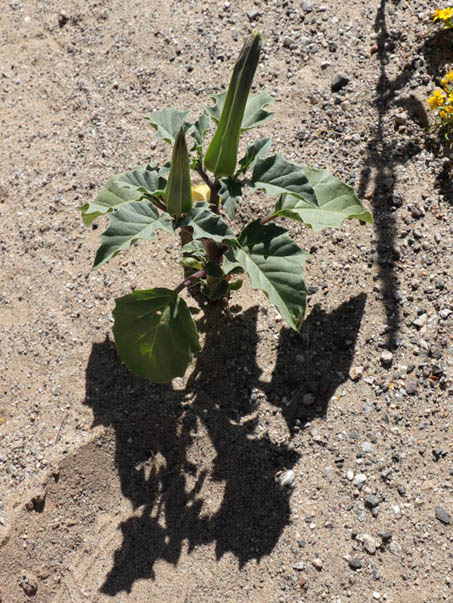
Desert Thornapple / Toloache
(Datura discolor, Solanaceae)
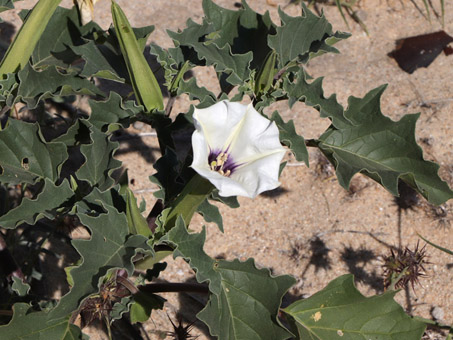
Desert Thornapple was widespread and abundant for most of our trip south. (Datura discolor, Solanaceae). Some plants were c. 1.5 m H!

Yuma Silverbush (Ditaxis serrata var. serrata, Euphorbiaceae) is most common in sandy substrates. It is monecious.

Each pistillate flower of Ditaxis serrata var. serrata is found at the base of a small raceme of staminate flowers. Here, several three-lobed fruits are visible.
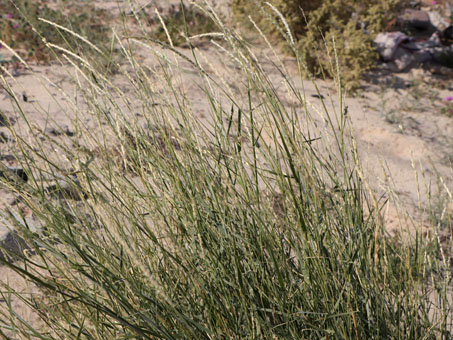
Zacate Galleta Gigante (Hilaria rigida, Poaceae).

Zacate Galleta Gigante (Hilaria rigida, Poaceae).
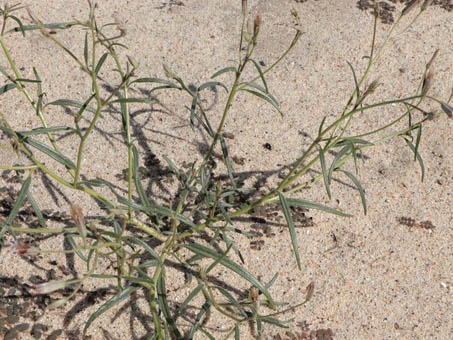
Desert Spanish Needle (Palafoxia arida var. arida, Asteraceae) is a native annual found most commonly in arid northeast Baja California.
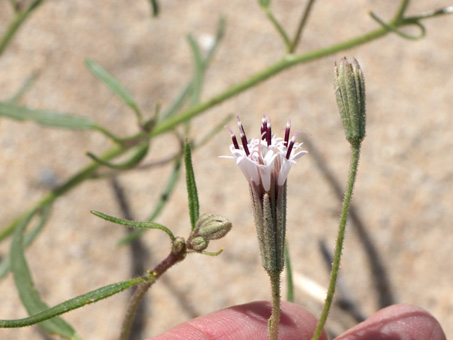
Palafoxia arida var. arida can be found far S as Laguna San Ignacio on the Pacific coast. Flower heads are c. 6-8 mm D & 15 mm L here.
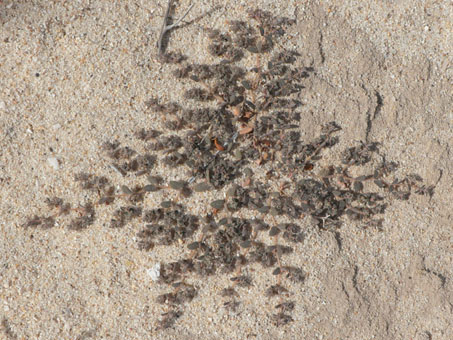
Gulf Sandmat / Golondrina (Euphorbia petrina, Euphorbiaceae). Superficially it resembles many of the other sandmats.

Gulf Sandmat (Euphorbia petrina), is a fairly rare native species but was abundant in the dunes around San Felipe.
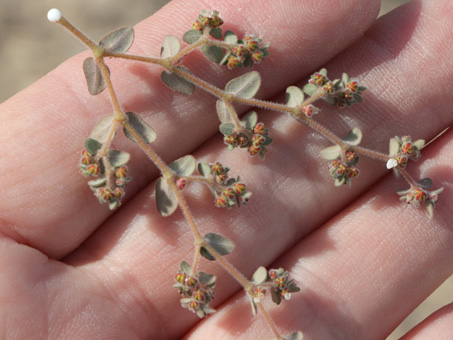
The red stripes on the fruit lobes of Euphorbia petrina are distinctive, telling me I was looking at a species I'd not seen before.
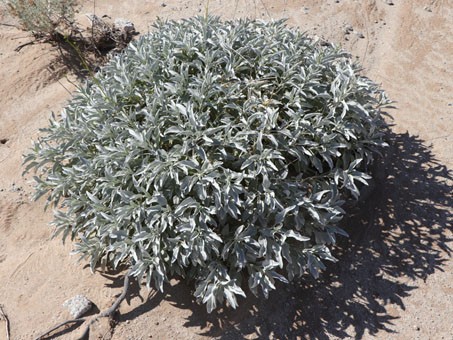
Incienso (Encelia farinosa, Asteraceae) is well adapted to the arid desert life with its densely hairy, gray-green leaves and thick sap.
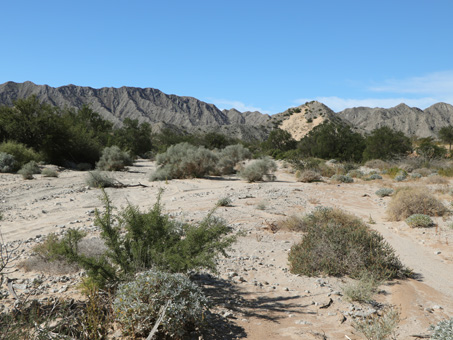
Arroyo near Km 8 S of San Felipe. The rocky Peninsular Range, seen here in the distance, is of tonolite origin.
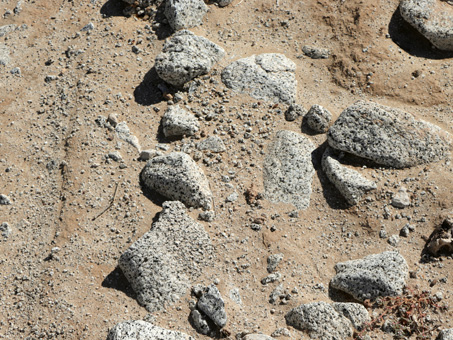
Over millenia, the boulders have eroded and rocks, gravel and sand has washed downhill towards the coast.
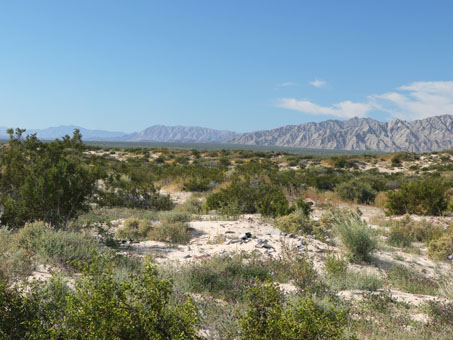
Around 16 km S of San Felipe, looking eastward at all the greenery on the sandy desert flat. The Burrobush (Ambrosia dumosa), Creosote (Larrea tridentata), Saltbush and Ocotillos were all very leafy.
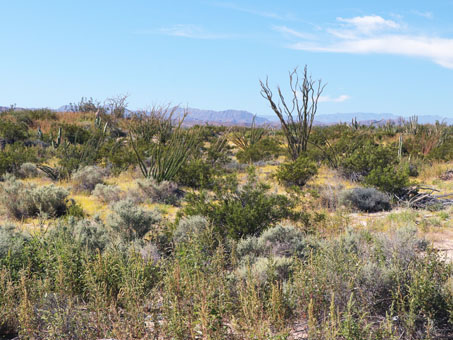
Around Km 29. There were lots of annuals between the shrubs and cacti, including an unidentified Amaranthus sp. and Southern Sandbur (in plague proportions), Sand Verbena...
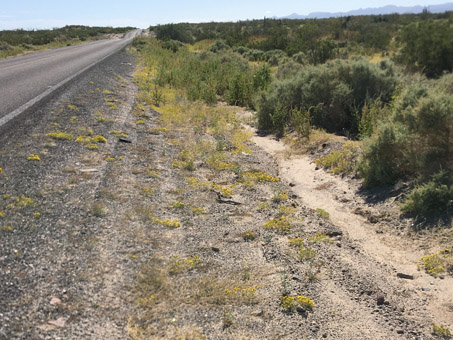
From N of San Felipe, the roadside & desert scrub was spotted with the brightly colored Desert Chinchweed (Pectis papposa var. papposa, Asteraceae).
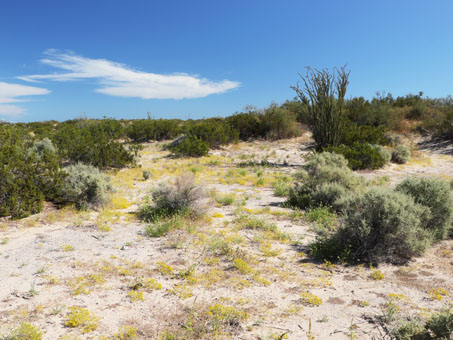
Desert Chinchweed / Manzanilla del Coyote was present for most of our trip, often as a dominant ground cover over extensive areas.
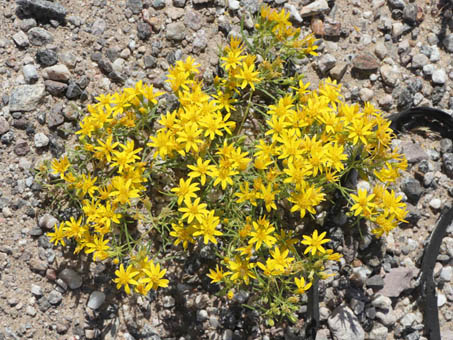
Pectis papposa var. papposa is a low, rounded, many-branched, gland-dotted annual.
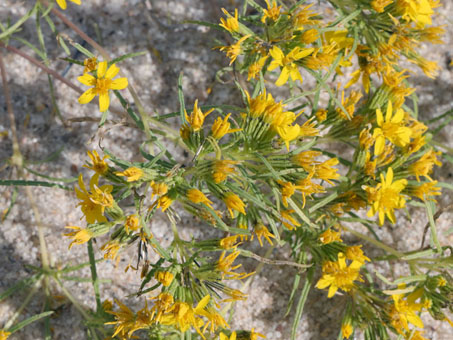
The herbage of Desert Chinchweed has a strong aroma—unpleasant to some. The strappy leaves have soft, marginal bristles.

Six-Weeks Three-Awn/Zacate Tres Barbas (Aristida adscensionis). This is a widespread, native annual grass found across most of the peninsula.
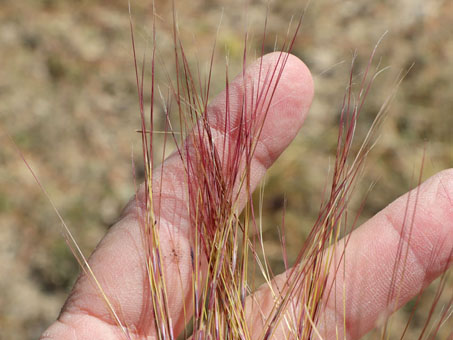
The habit of Six-Weeks Three-Awn grass is variable, ranging from these cute, tight clusters c. 20 cm H to taller, looser, leggy culms 50-60 cm H.
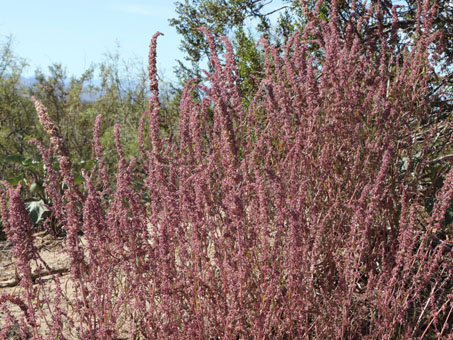
It was a bumper year for another colorful plant, Fringed Amaranth (Amaranthus fimbriatus). We started seeing it N of San Felipe and it continued sporadically southward to the Vizcaino Desert.
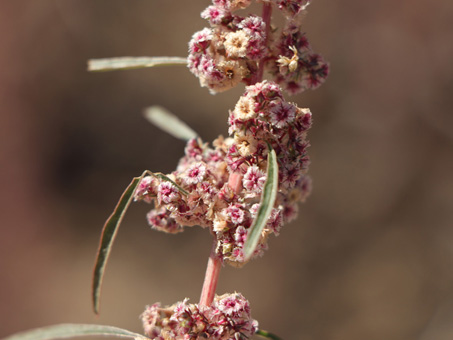
The perianth parts of Fringed Amaranth are fan-shaped, papery and c. 1.5-3 mm D with finely toothed margins. The leaves are linear to lanceolate, 2-6 cm x 1-10 mm W.
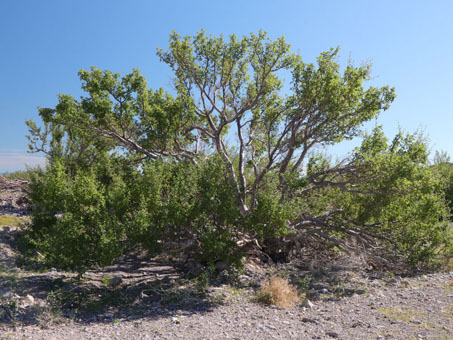
Around Km 54 S of San Felipe, we pulled over to explore a gravelly arroyo bed. The Red Elephant Tree / Torote Prieto (Bursera hindsiana, Burseraceae) were dense with leaves.
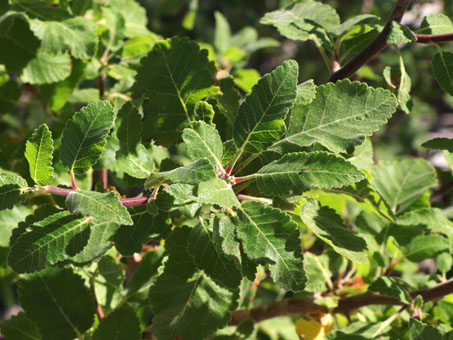
The furry leaves of the Red Elephant Tree are gen. 3-foliate & drought-deciduous. The trees in the arroyo were all still lush & green.
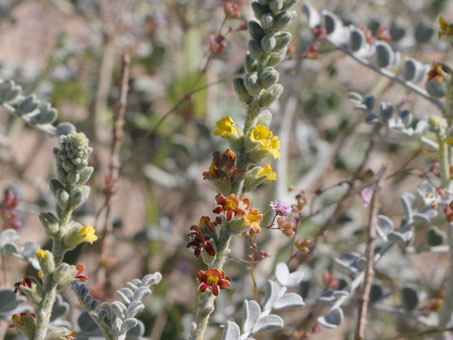
Gulf dunebroom (Errazurizia megacarpa, Fabaceae) herbage is silver-white due to a dense vestiture of hair. The yellow flowers age brownish-orange and are about 1 cm D.
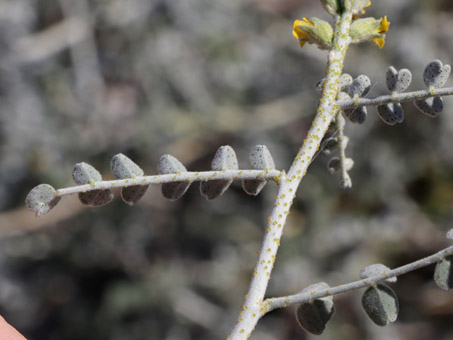
Gulfbroom is also spotted with golden glands. The herbage has a strong [unpleasant] scent.
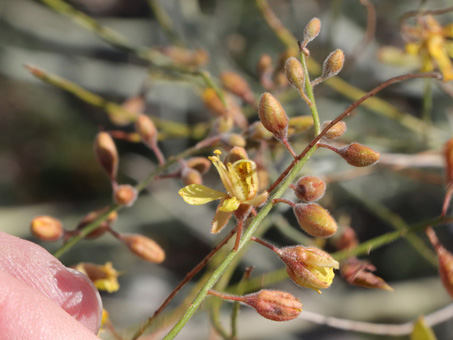
Desert Bird-of-Paradise (Hoffmannseggia microphylla, Fabaceae). The species is fairly common and abundant in some areas along the Gulf to about as far south as Bahia de los Angeles.
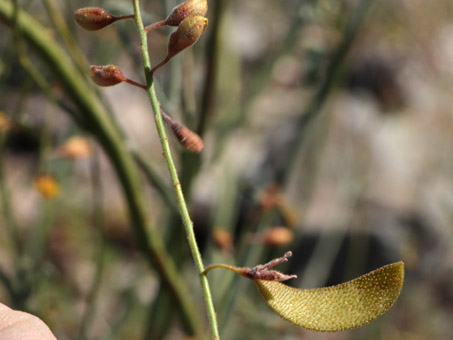
The gland-spotted fruit of Desert Bird-of-Paradise is about 3 cm L and resembles a Snowpea.
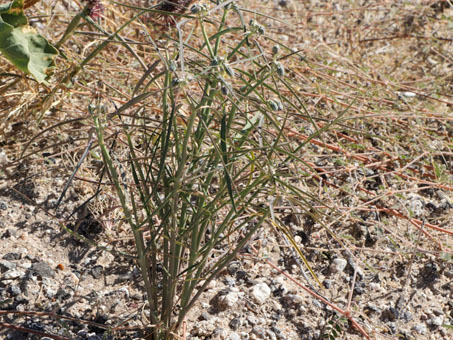
Beetle spurge (Euphorbia eriantha). This plant is about 40 cm H.
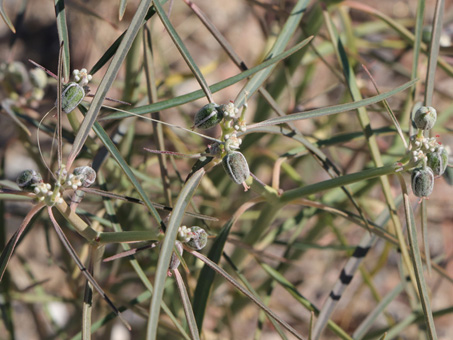
When viewed from just the right angle with the white line seen straight on, the fruit actually looks like a small gray-green beetle.
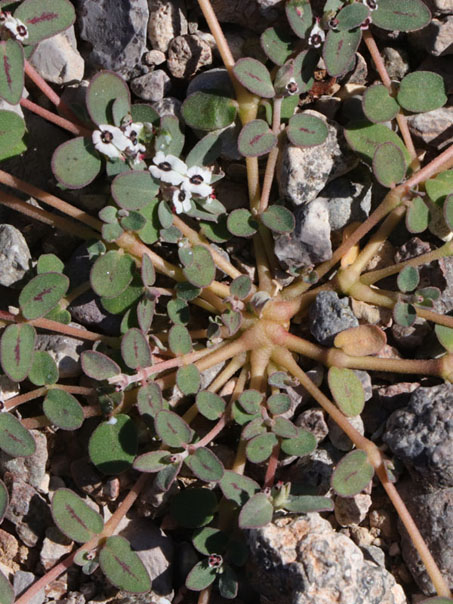
Another common sandmat, Louse Spurge / Golondrina (Euphorbia pediculifera var. pediculifera).
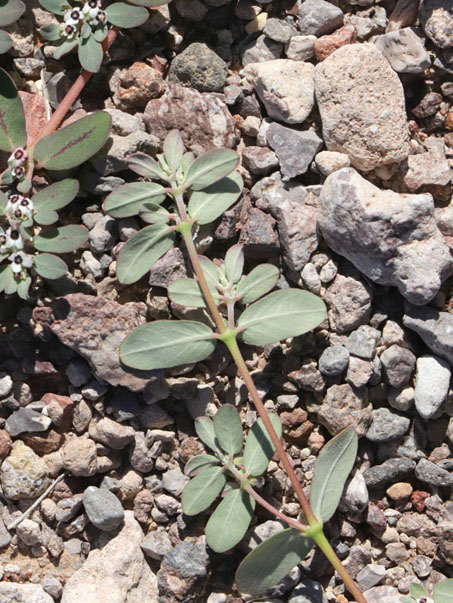
The underside of Louse Spurge. No lice here. Is it the flower that looks like lice? ¿Quién sabe?
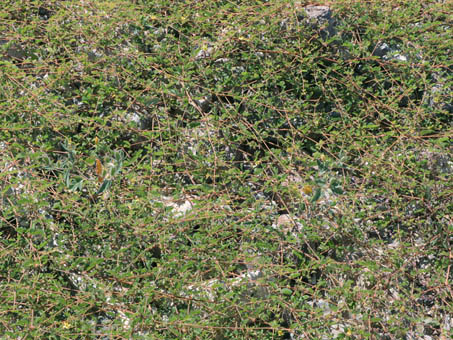
California Caltrop / Pela Gallina (Kallstroemia californica, Zygophyllaceae) covered many banks and dunes in the arroyo bed.

California Caltrop (Kallstroemia californica). Flowers are c. 1.5 cm D. Look closely for the club-shaped fruit on a long pedicle.
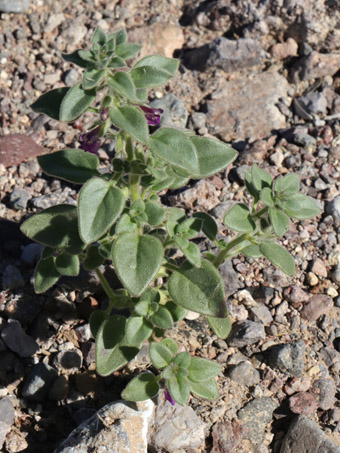
Canyon Snapdragon (Pseudorontium cyathiferum, Plantaginaceae). Plants were small, but flowery.

Canyon Snapdragon is common on the peninsula. Its leaves are fleshy & glandular hairy. Flowers: c. 8 mm.
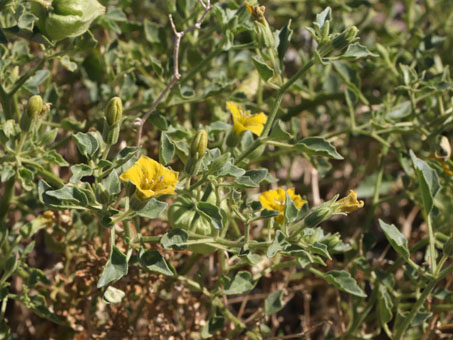
Baja California Groundcherry / Tomatillo (Physalis crassifolia var. infundibularia) flowers and fruit.
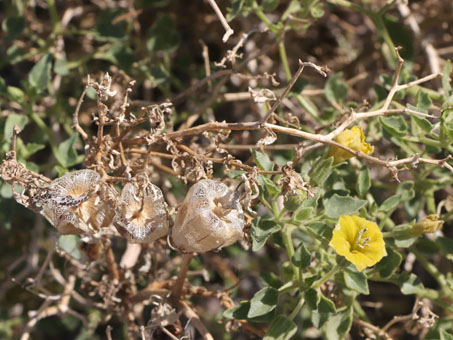
The inflated sepals of the California Groundcherry fruit become papery as they age and disintegrate slowly, exposing the small berry.
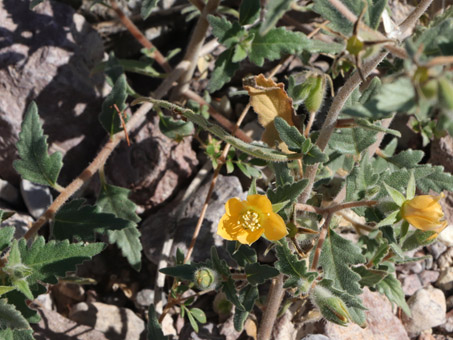
Blazing Star / Pegarropa (Mentzelia adhaerens, Loasaceae). Pegarropa in Spanish means "sticks to clothes", which it certainly does.
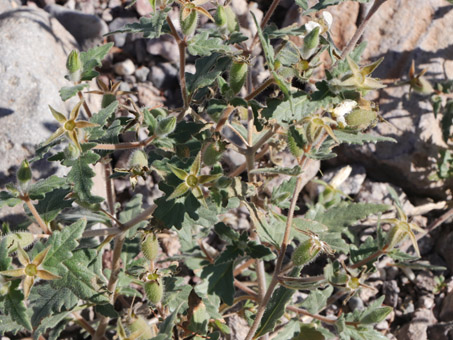
All of the herbage has velcro-like hairs that lock on to clothes, fur, even skin. It´s a great dispersal mechanism as well as a browsing deterrent.

Just when I thought I'd made it...
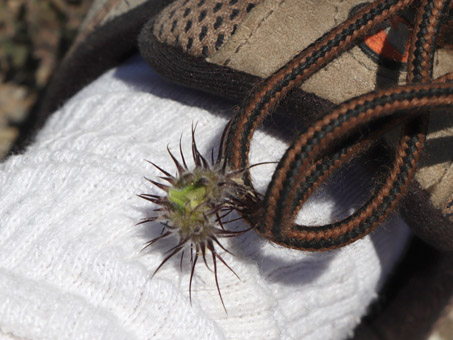
...I discovered several hitchhikers. Blazing Star leaf and a Sandbur.
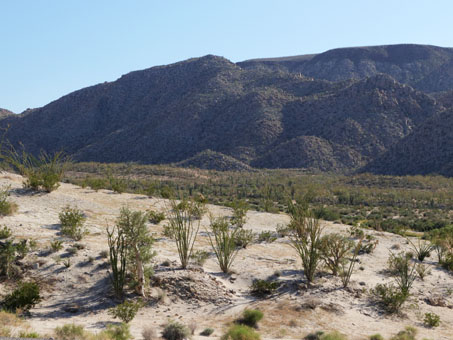
At Km 166 S of Puertecitos. The arroyo plants were still quite green, including Ocotillo (Fouquieria splendens) and Copalquin (Pachycormus discolor, Anacardiaceae).
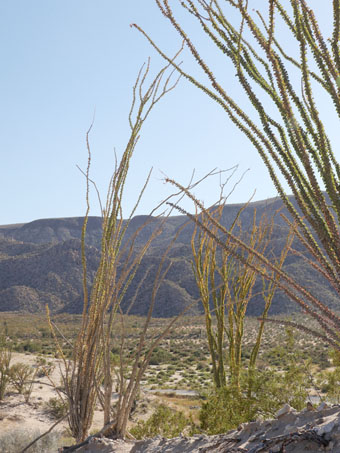
Some of the Ocotillo leaves were starting to turn color as the moisture on the hilltops decreased.
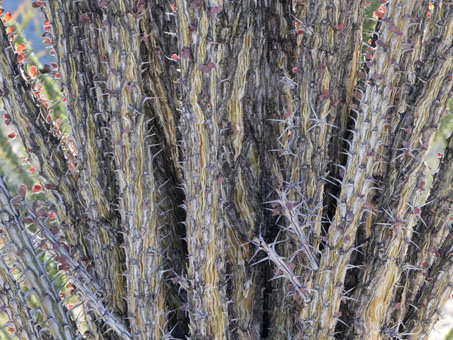
Ocotillo stems with the green, photosynthetic tissue that allows this species and its relatives the ability to idle its metabolism when leafless visible under the bark.
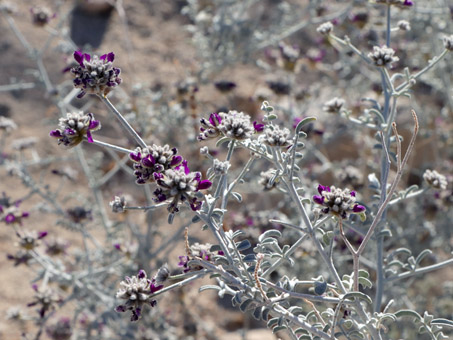
The Dye Bush (Psorothamnus emoryi var. emoryi) were over a meter tall and wide, silvery-green and loaded with clusters of dark purple flowers.
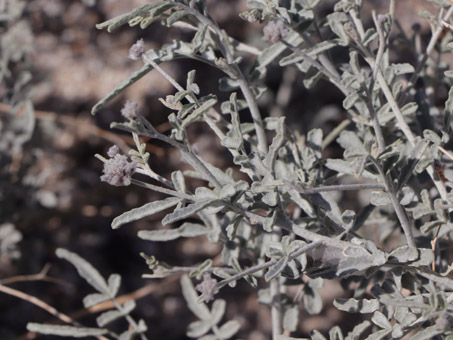
The leaves of Dye Bush are pinnate and canescent.
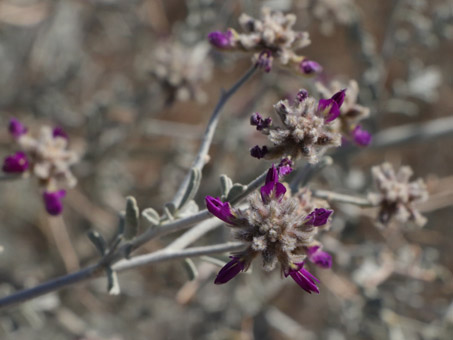
Each capitate inflorescence is about 1-1.5 cm D. The flowers are 5-8 mm L.
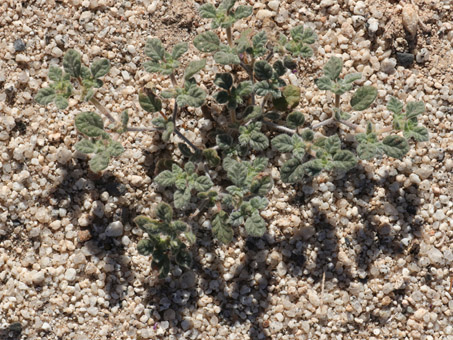
Palmer Crinklemat (Tiquilia palmeri, Ehretiaceae). A key feature of this species are the 3 (or so) sets of deeply impressed veins on the leaves and lack of a sharp spiny hair at the apex (= T. cuspidata).
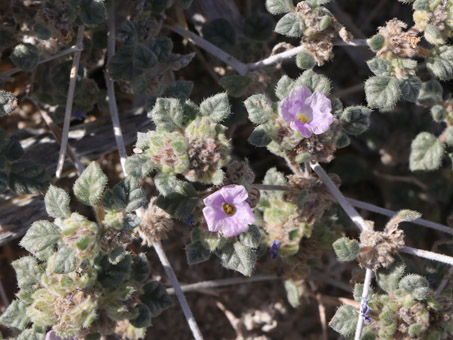
Flowers are pale to dark pink, purple or blueish and about 5-9 mm L and 10-12 mm D.
Laguna Chapala to Guerrero Negro
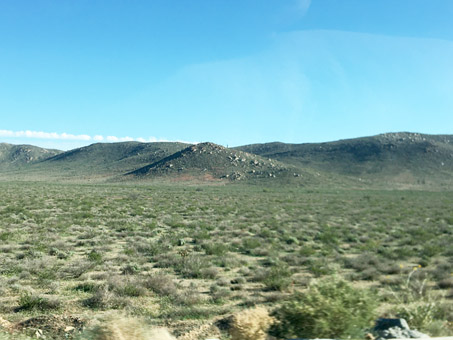
Approaching Laguna Chapala from the east, the creosote-saltbush scrub of the valley floor was greener than in our previous 4 trips.
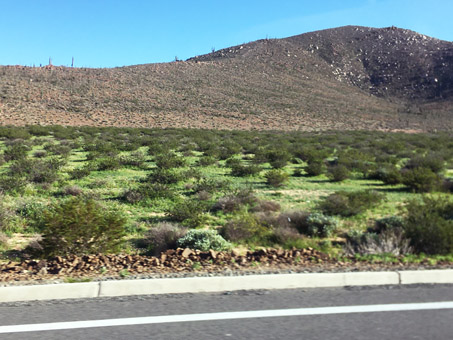
With no place to pull off of Hwy 5 as we approached Laguna Chapala, I wasn't able to identify the dense, bright green groundcover.
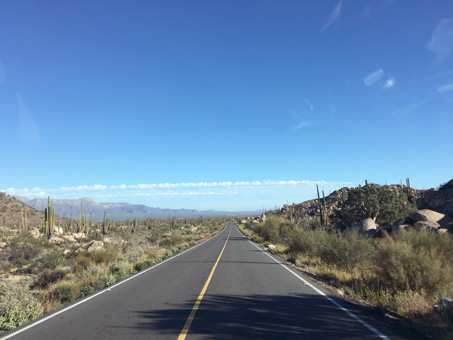
Near the bottom of the Portezuelo grade just south of Laguna Chapala, the view opens out into a wide valley bursting with leafy shrubs / trees. The distant mountain range is the Sierra la Asamblea.
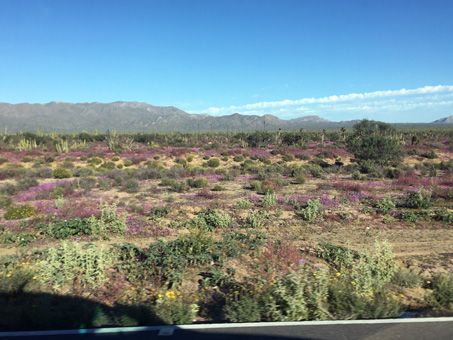
Mile after mile of Sand Verbena and Fringed Amaranth north of the turnoff to Bahía de los Ángeles.

More Sand Verbena and Fringed Amaranth north of the turnoff to Bahía de los Ángeles.
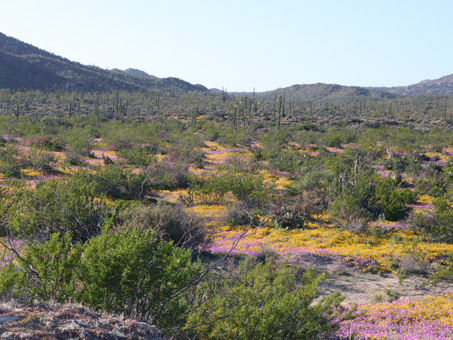
Here, more Sand Verbena mixed in with swathes of Desert Chinchweed (Pectis papposa var. papposa).

An incredible 180 degree view.

One of the few annual plants seen at our stop. Hairy Prairie-clover (Dalea mollis, Fabaceae).
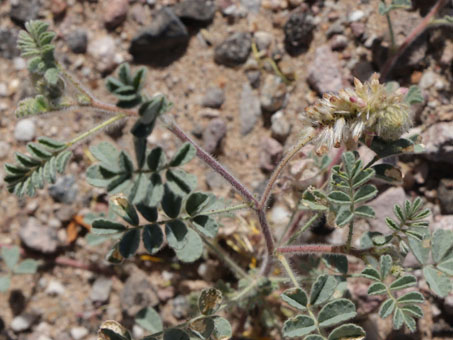
Dalea mollis (Fabaceae).
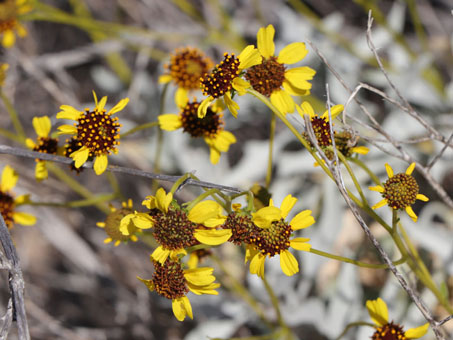
Brittlebush / Incienso (Encelia farinosa, Asteraceae).
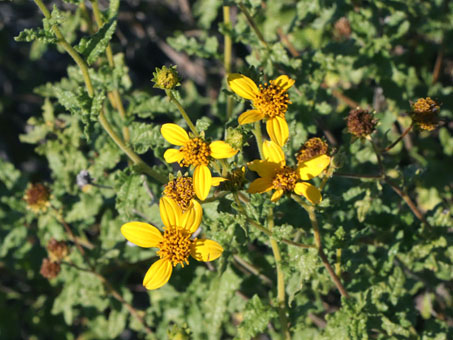
San Diego Sunflower / Margarita (Bahiopsis laciniata, Asteraceae).
While not at the end of our November trip south, we have reached the end of this month's entry. Next month, I'll follow up with a few more plants and some scenery between Guerrero Negro and Mulege as well as with some of what we saw when we first got to Mulege, just under two months post-hurricane. With the postponed publication of the Bee Hive earlier in the year, I now have lots of material piled up from our 2022-23 season. So stay tuned, and until next month, hasta luego...
Debra Valov—Curatorial Volunteer
References and Resources
Rebman, J. P., J. Gibson, and K. Rich, 2016. Annotated checklist of the vascular plants of Baja California, Mexico. Proceedings of the San Diego Society of Natural History, No. 45, 15 November 2016. San Diego Natural History Museum, San Diego, CA. Full text available online.
Rebman, J. P and Roberts, N. C. (2012). Baja California Plant Field Guide. San Diego, CA: Sunbelt Publications. Descriptions and distribution.
Wiggins, I. L. (1980). The Flora of Baja California. Stanford University Press. Keys and descriptions.
Elizabeth H. Zacharias 2013, Atriplex polycarpa, in Jepson Flora Project (eds.) Jepson eFlora, Revision 1,
https://ucjeps.berkeley.edu/eflora/eflora_display.php?tid=15258, accessed on December 17, 2022.




































































